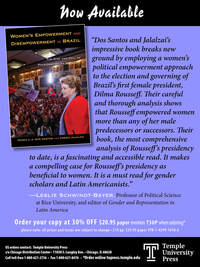
Research Agenda
My research focuses on Brazil's democratic institutions. Specifically, I have researched electoral rules, the Brazilian Congress, the executive, and executive-legislative relations. Most of my research is grounded on the representation literature and the ways in which elected officials represent their constituency. When thinking about representation in Brazil two specific groups spark my interest: women as a representational group and the growing evangelical population in the country.
Latest Works
Farida Jalalzai, Brianna Kreft, Lizbet Martinez-Port, Brigid Smith, and Pedro A. G. dos Santos (2022) “A tough woman around tender men: Dilma Rousseff, gendered double bind, and misogynistic backlash.” Frontiers in Political Science: Mind the Backlash: Gender Discrimination and Sexism in Contemporary Societies.
Malu A. C. Gatto, Kristin Wylie, and Pedro A.G. dos Santos (2022).“Gendering Coalitional Presidentialism in Brazil.” Journal of Politics in Latin America.
Pedro A. G. dos Santos. “Gendered Path Dependency: Women’s Representation in 20th Century Brazil.” European Journal of Politics and Gender 4 (3).
Pedro A. G. dos Santos and Farida Jalalzai (2021). Women's Empowerment and Disempowerment in Brazil: The Rise and Fall of President Dilma Rousseff. Temple University Press.
Kristin Wylie, Pedro dos Santos, and Daniel Marcelino (2019). “Extreme Non-viable Candidates and Quota Maneuvering in Brazilian Legislative Elections.” Opinião Pública 25 (1).
Laura A. Dean and Pedro A. G. dos Santos (2017). “The Implication of Gender Quotas in Ukraine: A Case Study of Municipal Party-Level Elections in Eastern Europe’s Most Precarious Democracy.” Teorija in Praksa 54 (2).
My research focuses on Brazil's democratic institutions. Specifically, I have researched electoral rules, the Brazilian Congress, the executive, and executive-legislative relations. Most of my research is grounded on the representation literature and the ways in which elected officials represent their constituency. When thinking about representation in Brazil two specific groups spark my interest: women as a representational group and the growing evangelical population in the country.
Latest Works
Farida Jalalzai, Brianna Kreft, Lizbet Martinez-Port, Brigid Smith, and Pedro A. G. dos Santos (2022) “A tough woman around tender men: Dilma Rousseff, gendered double bind, and misogynistic backlash.” Frontiers in Political Science: Mind the Backlash: Gender Discrimination and Sexism in Contemporary Societies.
Malu A. C. Gatto, Kristin Wylie, and Pedro A.G. dos Santos (2022).“Gendering Coalitional Presidentialism in Brazil.” Journal of Politics in Latin America.
Pedro A. G. dos Santos. “Gendered Path Dependency: Women’s Representation in 20th Century Brazil.” European Journal of Politics and Gender 4 (3).
Pedro A. G. dos Santos and Farida Jalalzai (2021). Women's Empowerment and Disempowerment in Brazil: The Rise and Fall of President Dilma Rousseff. Temple University Press.
Kristin Wylie, Pedro dos Santos, and Daniel Marcelino (2019). “Extreme Non-viable Candidates and Quota Maneuvering in Brazilian Legislative Elections.” Opinião Pública 25 (1).
Laura A. Dean and Pedro A. G. dos Santos (2017). “The Implication of Gender Quotas in Ukraine: A Case Study of Municipal Party-Level Elections in Eastern Europe’s Most Precarious Democracy.” Teorija in Praksa 54 (2).
